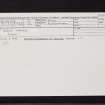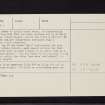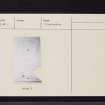West Mains
Cairn (Bronze Age), Dagger (Bronze)(Bronze Age)
Site Name West Mains
Classification Cairn (Bronze Age), Dagger (Bronze)(Bronze Age)
Canmore ID 31900
Site Number NO33NW 2
NGR NO 3151 3765
Datum OSGB36 - NGR
Permalink http://canmore.org.uk/site/31900
- Council Angus
- Parish Auchterhouse
- Former Region Tayside
- Former District City Of Dundee
- Former County Angus
NO33NW 2 3151 3765.
(NO 3151 3765) Cairn (NR)
OS 6" map, (1970)
A cairn occupies the summit of the Hill of West Mains. At the time of the excavations in 1897, this cairn was c. 63' in diameter and 5'6" high, but formerly had been higher. In the centre of the cairn was a double cist the two long sides each composed of one slab. The slabs were set into the subsoil which was only 4" - 5" deep. The cist was luted with clay, and the capstones were covered by a 3" layer of clay. Around the cist was a rough wall of stones. The cist and wall were covered by a mound about 20' or 30' in diameter, probably made of turves, containing broken pieces of quartz and quantities of "wood ashes". This mound was edged by a kerb of large stones, 3' high. The whole was covered by the cairn edged by a kerb of smaller stones.
The cist was divided into two compartments by a transverse slab, and was covered by six capstones. The larger compartment measured 2' x 2'2" x 2' deep. In it were two heaps of partly burnt bones, not necessarily representing more than one body, accompanied by an Early Bronze Age ribbed dagger, now in the National Museum of Antiquities of Scotland (NMAS Accession no: EQ 255). The smaller compartment contained only a thoroughly burnt cremation.
On top of the stone "wall" surrounding the cist were two bronze objects, each placed between two flat slabs. "Both were so much decayed as to exist only as a vivid green powder." One was about 10 cm long and 1.3 cm or less in width; the other "was more leaf-shaped", c. 7.5 cm in length.
A Hutcheson 1898; A S Henshall 1968; J M Coles 1971.
This cairn measures 21.0m E-W by 22.0m N-S and is 2.5m maximum height. No ditch or surrounding kerb are visible.
Visited by OS (J L D) 5 May 1958.
(Bronze dagger of Ridgeway group, Auchterhouse-Barrasford variant). Flat dagger, trapezoidal heel, six rivet-holes with six peg-rivets still in position; three loose peg-rivets; omega-shaped hilt-mark; triple-reeded midrib lined on each side by row of pointille (about twelve dots per cm); also faint line of dots along the grooves of the midrib; tip damaged; remains of horn hilt which survived in two badly warped and shrunken plates, its lower end showing traces of three rivet-holes; remains of animal skin sheath with horn mounts. Present length (blade) 16.4cm, reconstructed length (hilt and blade) 24.9cm, width 6.8cm.
S Gerloff 1975.
The monument comprises the remains of a burial cairn situated in rough pasture at around 290m OD on the summit of West Mains Hill. It is grass-covered and measures some 21m E-W by about 22m N-S, and about 1.5m maximum height. Excavations in 1897 uncovered a double cist in the centre of the cairn containing evidence for Bronze Age burials, along with signs of structural complexity in the cairn's construction. These early excavations are probably responsible for two areas of disturbance visible in the centre and on the NW of the cairn surface. The cairn is otherwise intact and is surmounted by an Ordnance Survey trig point and a modern monument apparently constructed from spoil from the 1897 excavations.
Information from Historic Scotland, scheduling document dated 23 December 1996.
Field Visit (7 September 1956)
CAIRN, WEST MAINS HILL.
The Trigonometrical Station and the modern cairn
on the summit of West Mains Hill both stand on the substantial remains of a
Bronze Age round cairn measuring 65 ft. in diameter and 4 - 5 ft. in height.
A ragged hole has been dug in the centre of the ancient cairn, but has not
exposed any cist or chamber.
Visited by RCAHMS (KAS) 7 September 1956
Reference (1963)
This site is noted in the ‘List of monuments discovered during the survey of marginal land (1956-8)’, published in Vol. 1 of the RCAHMS Inventory of Stirlingshire. The 26 monuments were listed by their name, classification, parish and county, and the list also includes an indication of whether they had been planned (P), whether they were visible only as a cropmark (C), and whether they were worthy of preservation (*).
Information from RCAHMS (GFG) 30 October 2012.
Publication Account (1987)
This spectacular cairn, situated at a height of 289 m OD and thus a conspicuous landmark from several directions, measures some 70 m in diameter and 2.5 m in height. It was excavated in 1897 when the various stages in the building of the mound were revealed: at its centre there was a double cist, the corners of which were sealed with clay to make it watertight; the cist was surrounded by boulders and this central setting was covered by a mound of turves and edged with a kerb of large boulders; finally the mound was covered with stones. The central cist contained two heaps of cremated bones and a bronze dagger in one compartment, and a cremation deposit in the other. Perhaps because the cist was so carefully sealed, not only do the bronze dagger blade and the bronze rivets by which the hilt was attached survive in good condition, but also fragments of the ox-horn hilt and mountings for a sheath, which was probably made of skin. The dagger and mountings are in the RMS, Queen Street, Edinburgh.
Information from ‘Exploring Scotland’s Heritage: Fife and Tayside’, (1987).














